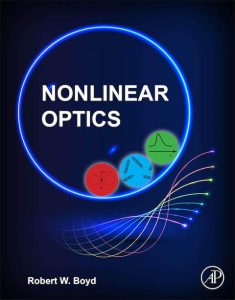About

- The Fourth Edition to my textbook Nonlinear Optics was published on April 1, 2020. Earlier editions were published in 1992, 2003, and 2008.
- The total number of copies sold to date is in excess of 15,000, and according to Google Scholar the book has been cited 18,066 times.
- Here are some details regarding this edition:
- Nonlinear Optics, Fourth Edition, Robert W. Boyd, Academic Press, Elsevier, Published March 31, 2020.
- Hardcover ISBN: 9780323850575
- Paperback ISBN: 9780128110027
- eBook ISBN: 9780128110034
- The book is available from Amazon or from the publisher at https://www.elsevier.com/books/nonlinear-optics/boyd/978-0-12-811002-7
Table of Contents and Preface to the Fourth Edition
Errata for the current (fourth) edition
Overall Comment: Gaussian is sometime written as Gaussian and sometimes as gaussian. Both spellings seem to be in use, although I think that Gaussian is generally accepted as the preferred form. We should change all occurrences of the word as Gaussian.
Page 5, Eq. (1.2.1) Change this equation to read: \tilde{E}(t) = Ee^{-i \omega t} + E^*e^{i \omega t} = Ee^{-i \omega t} + \mbox{c.c.} Also add a footnote after word “as” to read: Throughout this book we will use the notation + c.c. to mean that we are to add to the right-hand side of the equation the complex conjugate of the form displayed to the left of the + c.c. symbol.
Page 49, Table 1.5.3, in the third column for LiNbO3, change d_32 = -30 to read d_33 = -30.
Page 59, Eq. (1.7.9b). The omega in front of integral should be replaced by omega’ and placed inside the integral.
Page 84, the un-numbered equation three lines down from Eq. (3.5.2). The quantity n_i on the right-hand side of the equation should be replaced by n_1
Page 124, Figure 2.12.4, last sentence of caption should read: This situation is most desirable because walk-off is eliminated for θ = 90◦, and in addition the phase mismatch scales only quadratically with $ \delta \theta$.
Page 144, Eq. (3.2.25). In the last (third) line of the equation, in the second term in the denominator, one occurrence of omega_q should read \omega_p. The same change needs to be done in Eq. (3.2.26).
Page 177, line after equation (3.6.20). “represents the key vector” should read “represents the ket vector” and “(the bar vector)” should read “(the bra vector)”.
Page 184, Eq. (3.4.5), second line of the equation, the quantity E_m just before the closing parenthesis. The quantity E_m should be replaced by E_{\nu}
Page 200, part (b) of Problem 6. In the second equation, there is a minus sign that has been set as a subscript. The minus sign should be replaced by a subscript 1 and a minus sign should be added at text height to indicate normal subtraction. The latex code is $\chi^{(3)} (\omega_2 =
\omega_2 + \omega_1 – \omega_1)$
Page 346, Figure 7.2.7. Label inside of figure should say “input polarization,” not “linput”
Page 541, second-to-last line: “dispersive, nonlinear, nonlinear optical medium” should read “dispersive, nonlinear optical medium”
Page 552. Eq. (13.4.2); change 6 to 5.14 in the last form of this equation. Also, in Eq. (13.4.3) change 4 to 3.50 in two places in the equation.
Page 554, sentence immediately before Eq. (13.5.7), please insert the word “by” in the phrase “In the reference frame moving with the uniform translational velocity, the electron motion can be described [by] the equations”
Page 559, last line on the page should read “and tunneling ionization dominates for γK < 1.” That is, change greater than symbol to less than symbol
Page 560, Eq. (13.7.2). Change |omega to \omega_L in the center expression and omit the subscript r on the m_r in the right-most expression. Also, add a comma after this expression and add the following text to the next line: where tau represents the tunneling time though the barrier.
Page 562, ninth line from the top. Replace charged particles with polarizable particles and delete the words “such as electrons.”
Page 562, three lines above Eq. (13.8.7), change “to velocity v = c in a time” to “to a velocity $v$ comparable to $c$ in a time . . .” In the next line, add word thus so that the phrase reads “We thus set c . . .” In line after Eq. (14.8.7), change “with this field strength” to “with this peak field strength.”
Page 562, first complete sentence following Eq. (13.8.7), change “is of the other of” to “is of the order of”
Page 562, first complete sentence following Eq. (13.8.7), change “is of the other of” to “is of the order of”
Page 564, Eq. (13.8.17), in the third expression on this line, replace \omega_0 in the numerator with \omega_p
Page 565, first line, immediately after the in-line equation please add: “for light of vacuum wavelength \lambda”. Also, the symbol lambda-bar_C appears four times in this paragraph. Change the subscript to Roman capital C in all cases.
Page 570, caption to Fig. 14.2.1. Replace “change” with “charge.”
Page 572, Eq. (14.3.5). Replace the numerator Ne^2/m of the first form of the expression for \chi^{(1)} with Ne^2 / (m \epsilon_0)
Page 572, Eq. (14.3.7). Replace the minus sign in front of the imaginary term with a plus sign.
Page 578, the two lines immediately above Eq. (14.5.11). The fragment “form is” at the beginning of this paragraph should be omitted. Also, the first occurrence of the word “by” should be omitted and the words “are given” should be replaced by “is given” so that the text reads: “One similarly finds that the component of the propagation vector perpendicular to the interface is given in each of the two media by”
Page 583, last line of text. The units of epsilon are said to be C2N−1. The correct expression is C2N−1m−2.
Page 587, Eq. (A.21a). Change the second expression which now reads (1/epsilon _0) |D_0| to read (1/n^2 epsilon _0) |D_0|